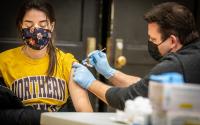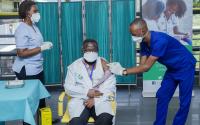[ad_1]
If you have received two doses of the COVID-19 vaccine and are exposed to someone with the virus, you no longer have to quarantine for 14 days as long as you remain free of symptoms, according to new recommendations issued by the Centers for Disease Control and Prevention (CDC).
Table of Contents
Guidance ahead of wider vaccine availability
Because the vaccines prevent symptomatic COVID-19 infections, and symptomatic people are thought to be more contagious, the CDC said the risk of unnecessary quarantine outweighs the potential unknown risk of transmission among vaccinated people.
If vaccinated people choose to skip quarantine after an exposure, the CDC said, they should only do so if it has been 14 days since their second dose, and they should continue to self-monitor for symptoms.
The CDC’s COVID Data Tracker shows 68,285,575 COVID-19 vaccine doses have been delivered in the United States, and 46,390,270 have been administered. About 10% of Americans have had at least one dose of either the Pfizer or Moderna vaccines.
This morning, Anthony Fauci, MD, director of the National Institutes of Allergy and Infectious Diseases, appeared on NBC’s Today show and said by April most Americans who want a vaccine will be able to easily obtain one, saying this spring would be an “open season.”
“As we get into March and April, the number of available doses will allow for much more of a mass vaccination approach,” Fauci said. “I would imagine by the time we get to April, that will be what I would call, for better wording, ‘open season.’ Namely, virtually everybody and anybody in any category could start to get vaccinated.”
Fauci also demonstrated on live TV how two masks can offer a closer fit and more protection against COVID-19, following a recommendation made yesterday by the CDC to layer surgical masks with cloth masks, or use a mask fitter.
California identifies first B1351 variant cases
Governor Gavin Newsom of California said his state has identified its first cases of the B1351 COVID-19 variant, one each in Alameda County and Santa Clara County. The B1351 strain, also known as the South African strain, has been less susceptible to currently approved vaccines.
So far only three states have reported a total of nine B1351 cases, according to the CDC. The most common variant in the United States is B117, or the UK variant. There are 932 confirmed B117 cases in 34 states.
Both B117 and B1351 are more contagious than the original, wild type SARS-CoV-2 virus. Another variant, P1, has produced three cases in two states.
Yesterday the United States reported 93,166 new COVID-19 cases, and 3,219 deaths, according to the Johns Hopkins COVID-19 tracker. In total, the nation has 27,356,234 cases, including 474,198 deaths.
Polls: COVID seen as lower risk, mental health impact
Also today a new Axios-Ipsos poll shows Americans’ perception of risk from the coronavirus is the lowest it’s been since October. Two thirds of respondents said returning to a prepandemic life is a moderate or large risk.
Young people (ages 18 to 29) and Republicans were the least likely to perceive the virus as a risk, with only 58% and 49% of those groups saying they see the virus as a risk at this time.
Most poll respondents showed confusion about how and when to begin to return to prepandemic life.
“As an example, on attending gatherings of family or friends, a quarter (28%) are already doing it, a quarter (22%) will wait for their circle to be vaccinated, a quarter (24%) will wait for officials to say it is safe, and a quarter (24%) don’t know,” Ipsos said in a press release on the survey.
The Kaiser Family Foundation also released a new poll on the implications of COVID-19 on Americans’ mental health and substance use. Roughly 4 in 10 American adults have reported symptoms of anxiety or depressive disorder during the pandemic.
The number is even higher (56%) in young adults (ages 18 to 24), who are also twice as likely as all adults to report substance abuse (25% vs 13%) and suicidal thoughts (26% vs 11%).
[ad_2]
Source link












